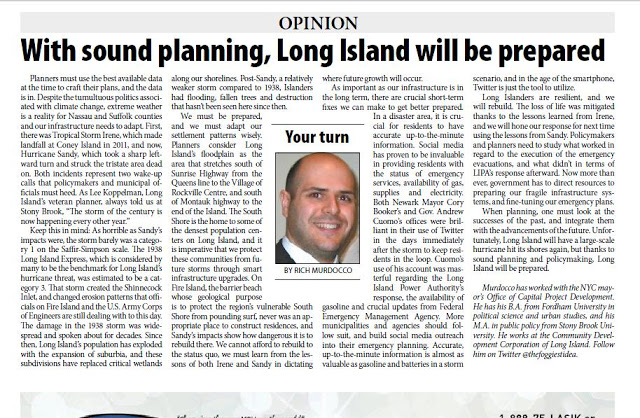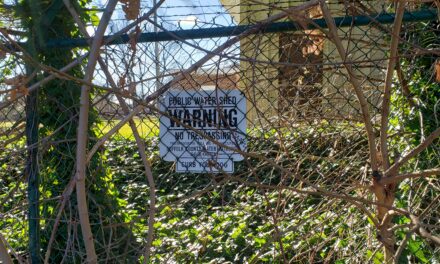The following piece appeared on the NYMuniBlog and the Times Beacon Record both online and in print. The original is below:
Planners must use the best available data at the time to craft their plans, and the data is in. Despite the tumultuous politics associated with climate change, extreme weather is a reality for Nassau and Suffolk Counties and our infrastructure needs to adapt. First, there was Tropical Storm Irene, which made landfall at Coney Island in 2011, and now, Superstorm Sandy, which took a sharp leftward turn and struck the Tristate area dead on. Both incidents represent two wake up calls that policymakers and municipal officials must heed. As Dr. Lee Koppelman, Long Island’s veteran planner, always told us at Stony Brook, “The storm of the century is now happening every other year.”
Keep this in mind: As horrible as Sandy’s impacts were, the storm barely was a Category One storm on the Saffir-Simpson Scale. The 1938 “Long Island Express”, which is considered by many to be the benchmark for Long Island’s hurricane threat, was estimated to be a Category Three. That storm created the Shinnecock Inlet, and changed erosion patterns that officials on Fire Island and the Army Corp of Engineers are still dealing with to this day. The damage in the 1938 storm was widespread and spoken about for decades. Since then, Long Island’s population exploded with the expansion of suburbia, and these subdivisions replaced critical wetlands along our shorelines. Post-Sandy, a relatively weaker storm compared to 1938, Long Islanders experienced flooding, fallen trees and destruction that hasn’t been seen in the region.
We must be prepared, and we must adapt our settlement patterns wisely. Planners consider Long Island’s floodplain as the area that stretches south of Sunrise Highway (NYS 27) from the Queens line to the village Rockville Centre, and south of Montauk highway (NYS 27A) to the end of the Island. The south shore is the home to some of the densest population centers on Long Island, and it is imperative that we protect these communities from future storms through smart infrastructure upgrades. The elevation of housing units, natural vegetative buffers and the restoration of wetlands should take priority. On Fire Island, the barrier beach whose geological purpose is to protect the region’s vulnerable south shore from pounding surf, never was an appropriate place to construct residences, and Sandy’s impacts show how dangerous it is to rebuild on the ever shifting sands. We cannot afford to rebuild to the status quo, we must learn from the lessons of both Irene and Sandy in dictating where future growth will occur.
As important as our infrastructure is in the long term, there are crucial short term fixes we can make to get better prepared. In a disaster area, it is crucial for residents to have up to the minute information that is accurate. Social media has proven to be invaluable in providing residents with the status of emergency services, availability of gas, supplies and electricity. Both Newark Mayor Cory Booker, and New York State Governor Cuomo’s office was been brilliant in their use of Twitter in the days immediately after the storm with keeping residents in the loop. Cuomo’s use of his account was masterful regarding LIPA’s response, the availability of gasoline and crucial updates from FEMA. More municipalities and agencies should follow suit, and build social media outreach into their emergency planning. On Long Island, I have seen several townships follow my advice and further develop their social media outreach to residents. Accurate, up to the minute information is almost as valuable as gasoline and batteries in a storm scenario, and in the age of the smartphone Twitter is just the tool to utilize.
Long Islanders are resilient, and we will rebuild. The loss of life was mitigated thanks to the lessons learned from Irene, and we will hone our response for next time using the lessons from Sandy. Policymakers and planners need to study what worked in regards to the execution of the emergency evacuations, and what didn’t in terms of LIPA’s response afterwards. Now more than ever, government has to direct resources to preparing our fragile infrastructure systems, and fine tuning our emergency plans. Through cooperation across the Federal, State, County, Local and Village governments, we will be ready.
When planning, one must look at the successes of the past, and integrate them with the advancements of the future. Unfortunately, Long Island will have a large scale hurricane hit its shores again, but thanks to sound planning and policymaking, Long Island will be prepared.












